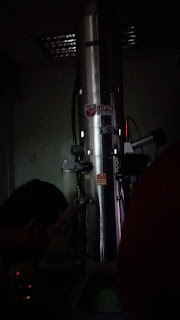Today’s topic is on prokaryotic cells.
Eventhough I have learnt this topic since my secondary
school then go on in my matriculation studies, I still learnt it now. I’m
telling you it’s not going to be boring as long as you are still want to figure
out and still want to know about it more and the fact is, I still can’t
remember the name of the microbes that I’ve learnt before.
What have I learnt about prokaryotic is that they are very
tiny microorganism and they are also simple compare to eukaryote. As everyone
very familiar with these microorganisms, these prokaryote are divided into two
categories which is the bacteria and archae. Both of them are similar but they
are different. Bacteria can be differentiate with it cell wall either they lack
of peptidoglycan or not and one of them have bigger periplasmic space which is
the gram negative bacteria which the space contain hydrolytic enzyme.
Here are the cell wall structure for gram positive bacteria that i would like to share
this the cell wall structure of gram negative bacteria:
as you can see from above picture, the differences that they have is the gram negative does no contain techoic acid and it has thin layer of peptidoglycan compared to gram positive bacteria.
They also have these kind of external structure of cell wall
which is glycocalyx, flagella, axial filament and pili. The structure that I
thing I’ve never heard before is the glycocalyx. Glycocalyx is a coating that
is secreted by the bacteria which is they use it to protect them from
dehydration. It also contribute to bacterial virulence to which it can cause
disease. they also known as capsule when it is organized and firmly attached to cell wall. when it is unorganized and loosely attached it is called slime layer.
They also have the structures internal to cell wall which
include the plasma membrane, cytoplasm, nuclear area, ribosomes and inclusion.
All of them are very familiar to me and all of my colleague. So I would like to
share about the inclusion part which I’m not so familiar with it.
This inclusions are very important to the bacteria which is
it act and serve as a basis of identification. The types of inclusions are:
·
Metachromatic granules
Which known collectively as volutin. It can
be found in algae, fungi and protozoa. It contain polyphosphate for synthesis
of ATP. Example of algae that can be
found is the
Corynebacterium diphtheria.
 |
| Metachromatic granules |
· - Polysaccharide granules
Consist glycogen and starch
· - Lipid inclusions for lipid storage. It is stain
by the Sudan dye
· - Sulphur granules
It present in sulphur bacteria (
thiobacillus) which they use sulphur as
energy reserve.
· - Carboxysome
Contain enzyme ribulose 1,5-diphosphate
carboxylase which is used for carbon fixation. They can be found in
photosynthetic and nitrifying bacteria.
· - Gas vacuoles
Found in aquatic prokaryotes in order to
maintain buoyancy so that the cell can remain at the desire depth in the water.
·
Magnetosome
It act like a magnet to decomposed hydrogen
peroxide which protect the cell from hydrogen peroxide accumulation.
Bacteria also produce endospore when they are in
unfavourable conditions. This is because the endospore is highly resistant to
environmental stress such as:
- - High temperatures
- - Irradiation
- - Strong acid
- - Disinfectants
What I’m hoping from this topic is that I hope that I can be
more interested to study about this microbe world because for me I’m not that
good in remembering it really well about their characteristic with its
functions because I might find it very difficult. So that I hope I can have
more time to do some search on this this prokaryote topic.





















































